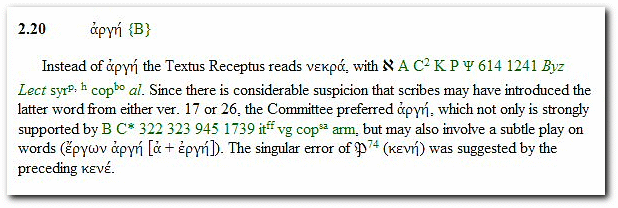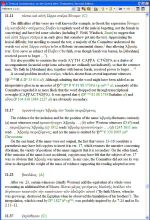 A
Textual Commentary on the Greek New Testament - Metzger CD-ROM
A
Textual Commentary on the Greek New Testament - Metzger CD-ROM
Metzger, Bruce M., A Textual Commentary on the Greek New Testament (2nd
Edition), Stuttgart: Deutsche Bibelgesellschaft, 1994.
This work is a companion volume to the fourth edition of the United Bible
Societies' Greek New Testament (UBS4), published by the German Bible Society
on behalf of the United Bible Societies early in 1993. It also makes a great
companion to the Stuttgart Electronic Study Bible, which contains the
critical apparatus of the NA27 Novum Testamentum Graece, and to Comfort &
Barrett's Text of the Earliest New Testament Greek Manuscripts.
Benjamin Chapman, author of Greek New Testament Insert, says this of
Metzger's Textual Commentary:
"One does not have to be a textual critic to benefit from the results of
textual criticism. A Textual Commentary on the Greek New Testament,
edited by Bruce M. Metzger, provides concise comments and explanations for
the choices among variants made by the editorial committee that produced the
United Bible Societies' The Greek New Testament. The Textual Commentary
is in plain English and requires no technical skills of its readers. Every
interpreter should at least open this book to his text and read the few
paragraphs there concerning whatever variants may be involved."
Value of the Textual
Commentary
Why is a book like Metzger's Textual Commentary valuable? The best
answer to this question is to offer an example using the screenshot below (Fig.
1).
Consider James 2:20, which the KJV translates as: "But wilt thou know, O
vain man, that faith without works is dead?" This same verse, in the ESV,
reads: "Do you want to be shown, you foolish person, that faith apart from
works is useless?" Now, why the discrepancy? Why does the KJV use dead, and
the ESV use useless? Does the Greek word there really have that variable of
a meaning?
The Textual Commentary is a resource that can be used to answer this
question.

Figure 1 — James 2:20 in Textual Commentary
Looking at the entry for James 2:20, we see immediately that the
manuscript tradition of the KJV New Testament (the Textus Receptus) reads
νεκρα, which is
the Greek word for dead. We also see that several manuscripts agree with
this tradition. The symbols here refer to Greek manuscripts. For instance,
the Hebrew aleph represents Codex Sinaiticus, the A represents Codex
Alexandrinus, C2 represents
the second corrector's "hand" in Codex Ephraemi Rescriptus, and so on. Each
of these sigla are implemented as information popups, so one need only hover
or click to get information on the manuscripts.
However, continuing on in the entry, we see that the editors of the
UBS4/NA27 Greek New Testament have suspicions concerning the use of
νεκρα. Metzger
explains, "Since there is considerable suspicion that scribes may have
introduced the latter word (i.e.,
νεκρα) from
either ver. 17 or 26, the Committee preferred
αργη ..." The
manuscript evidence for this preference is laid out next, consisting of a
number of other Greek manuscripts that support the reading of
αργη. This is
the word that the ESV translates as useless.
The Textual Commentary offers insight as to the considerations and
internal dialogue of the Committee that produced the UBS4/NA27 Greek New
Testament. Interestingly, for the set of critical readings (over 600) chosen
for the edition, the user of this resource has at his fingertips what
amounts to a commentary and explanation of the UBS4 apparatus. Instead of
simply listing the variant evidence as the apparatus does, explanation is
given. This explanation is what gives this resource value, and what makes it
useable.
The example from James 2:20 is only one of many. Examine the entry for James
2:19 above, or perhaps the entry for James 3:9. The Textual Commentary
is full of such insight and explanation, and as such is a valuable
supplement to any reference library designed to assist exegetes and textual
critics of the Greek New Testament.
Below are the prefaces to the first and second editions of the Textual
Commentary, which explain more about the contents of the book and its
purpose.
Prefaces
PREFACE TO THE FIRST EDITION
The present volume is designed to serve as a companion to the third edition
of the United Bible Societies' Greek New Testament (UBS3), edited by Kurt
Aland, Matthew Black, Carlo M. Martini, Bruce M. Metzger, and Allen Wikgren.
One of the chief purposes of the commentary is to set forth the reasons that
led the Committee, or a majority of the members of the Committee, to adopt
certain variant readings for inclusion in the text and to relegate certain
other readings to the apparatus. On the basis of a record of the voting of
the Committee, as well as, for most sessions, more or less full notes of the
discussions that preceded the voting, the present writer has sought to frame
and express concisely (a) the main problem or problems involved in each set
of variants and (b) the Committee's evaluation and resolution of those
problems. In writing the commentary it was necessary not only to review what
the Committee had done, but also to consult once again the several
commentaries, concordances, synopses, lexicons, grammars, and similar
reference works that had been utilized by members of the Committee during
their discussions. More than once the record of the discussion proved to be
incomplete because, amid the lively exchange of opinions, the Committee had
come to a decision without the formal enunciation of those reasons that
appeared at the time to be obvious or self-evident. In such cases it was
necessary for the present writer to supplement, or even to reconstruct, the
tenor of the Committee's discussions.
The general Introduction to the commentary includes an outline of the chief
kinds of considerations that the Committee took into account in choosing
among variant readings. By becoming acquainted with these criteria (pp.
10*-14*) the reader will be able to understand more readily the
presuppositions that underlie the Committee's evaluations of the divergent
readings.
In addition to the 1440 sets of variant readings supplied in the apparatus
of the Bible Societies' edition, the selection of which was made chiefly on
the basis of their exegetical importance to the translator and student, the
Committee suggested that certain other readings also deserved discussion in
the supplementary volume. The author has therefore included comments on
about 600 additional sets of variant readings, scattered throughout the New
Testament; the majority of them, it will be noted, occur in the book of Acts,
which, because of its peculiar textual problems, seemed to demand special
attention (see the Introduction to the book of Acts).
In the comments on the variant readings for which the text-volume supplies
an apparatus, it was considered sufficient to cite merely the more important
manuscript witnesses; the reader of the commentary will be able to
supplement the partial citation of evidence by consulting the fuller
apparatus in the text-volume. On the other hand, occasionally the discussion
in the commentary supplements the apparatus in the text-volume by the
citation of additional witnesses, a few of which were not known at the time
of the Committee's work, and others of which had been deemed unimportant for
citation in the apparatus. Since the present volume is designed to assist
translators and students who may not have available an extensive library,
the comments on the 600 additional sets of variant readings are accompanied
by a more or less full citation of evidence, drawn from such standard
apparatus critici as those of Tischendorf, von Soden, Nestle, Merk, Bover,
Souter, Hoskier (for Revelation), and Wordsworth and White, as well as from
editions of individual manuscripts.
The writing of the commentary was begun during 1964, when the author, on
sabbatical leave from his usual academic duties, was a member of the
Institute for Advanced Study in Princeton. During the following years, as
the first draft of each major section was completed, it was circulated among
the other members of the Committee to make certain that the comments
reflected adequately the Committee's deliberations. Frequently it had
happened that the members of the Committee differed in their evaluation of
the textual evidence, and thus many readings were adopted on the basis of a
majority vote. In special cases, when a member holding a minority opinion
had strong feelings that the majority had seriously gone astray, opportunity
was given for him to express his own point of view. Such occasional comments,
identified by the writer's initials and enclosed within square brackets, are
appended to the main discussion of the textual problem in question.
...
BRUCE M. METZGER
Princeton Theological Seminary
September 30, 1970
PREFACE TO THE SECOND EDITION
The present edition of this Textual Commentary has been adapted to the
fourth revised edition of The Greek New Testament (UBS4), published by the
German Bible Society on behalf of the United Bible Societies early in 1993.
This means that each of the 284 additional sets of variant readings that
were included by Committee decision in the apparatus of the fourth edition
has now a corresponding entry in the Commentary. On the other hand, the
comments on almost all of the 273 sets of variant readings that the
Committee removed from the apparatus, because the variants were of less
significance for translators and other readers, are no longer retained in
the Commentary.
Other adjustments have also been made. For example, the implications of
recent discussions concerning the so-called Caesarean text are reflected at
various places in the Commentary. Further bibliographical items have been
added here and there, particularly in connection with the expanded
discussion of problems relating to the two main types of text in the book of
Acts.
As was true in the earlier edition of the Commentary, textual discussions
are usually supplied with the citation of only the more important manuscript
witnesses. In some cases this information differs slightly from the citation
given in the apparatus for those passages in the fourth edition of the Greek
text. For example, certain later Greek uncial manuscripts as well as
evidence from the Gothic version, which are no longer cited in the fourth
edition of the text volume, continue to be cited here. On the other hand,
additional minuscule manuscripts as well as evidence from the Old Church
Slavonic version, which are now included in the apparatus of the fourth
edition, are not repeated here. For a statement of the different principles
followed in selecting witnesses to be cited in the third and the fourth
editions, see the Introduction to each edition.
...
BRUCE M. METZGER
Princeton Theological Seminary
September 30, 1993
Page Scans and Screenshots
Page scan of the print version and screenshots of the Libronix DLS version.
James 2:19-25 in the print Commentary and Libronix edition.

Hebrews 11:11-23 in the
Libronix edition. Note the faithful reproduction of the Greek uncials. The
font used is based on the letterforms from Codex Sinaiticus.
| Стоимость CD-ROM: 10 у.е. |


